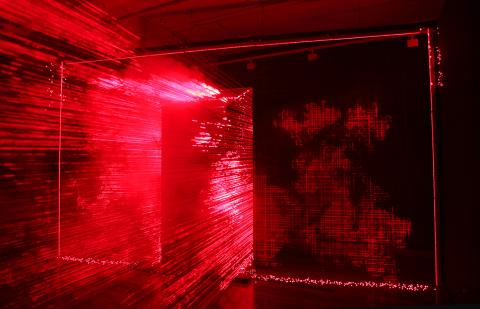Reality Impalpable (不確定的真相) is a solo exhibition of works by Chinese artist Li Hui (李暉). Li’s light installations — including one composed of 13,000 LEDs — are meant to serve as a symbol of China’s hectic and rapidly changing society, particularly his hometown of Beijing, which is contrasted with the philosophies of Buddhism and Confucianism.
■ Museum of Contemporary Art, Taipei (MOCA, Taipei), 39 Changan W Rd, Taipei City (台北市長安西路39號), tel: (02) 2552-3720. Open Tuesdays to Sundays from 10am to 6pm. Admission: NT$50
■ Opening reception on Friday at 6pm. Until June 26

Photo courtesy of MOCA, Taipei
Return to the Essence (返本歸真) surveys Taiwan’s abstract painting scene through the work of five artists: Chu Teh-i (曲德益), Lee Shi-chi (李錫奇), Tsong Pu (莊普), Yang Chi-hung (楊識宏) and Hsueh Pao-shia (薛保瑕).
■ Red Gold Fine Art (赤粒藝術), 15, Ln 116, Da-an Rd Sec 1, Taipei City (台北市大安路一段116巷15號), tel: (02) 8772-5887. Open Tuesdays to Sundays from 11am to 7pm
■ Opening reception on Sunday at 3pm. Until May 29
Modigliani and his Circle showcases works by and documents about Italian figurative painter Amedeo Modigliani and some of his friends and contemporaries, including Moise Kisling and Max Jacob. This is the first exhibition dedicated to Modigliani in Asia.
■ Kaohsiung Museum of Fine Arts, 80 Meishuguan Rd, Greater Kaohsiung (高雄市美術館路80號), tel: (07) 555-0331. Open Tuesdays to Sundays from 9am to 5pm. Admission: NT$260
■ Until July 31
Shanghai’s influx of foreign influences toward the end of the 19th century set traditional Chinese ink painting on a new trajectory, as an exhibit of 20 works by 16 artists at 99 Degrees Art Center attempts to show. The pluralistic tradition that evolved from the merging of disparate cultures and artistic styles continues to the present day. The works on exhibit span the past 100 years and include examples by Ren Bonian (任伯年), Wu Changshuo (吳昌碩), Huang Binhong (黃賓虹) and Chang Dai-chien (張大千).
■ 99 Degrees Art Center (99度藝術中心), 5F, 259, Dunhua S Rd Sec 1, Taipei City (台北市敦化南路一段259號5樓), tel: (02) 2700-3099. Open Tuesdays to Sundays from 11am to 6pm
■ Until May 29
The Animal’s Soliloquy (動物的獨白) presents a new series of surrealist and psychedelic paintings of animals by Johnny Leo (廖文彬). Leo’s dreamy paintings address environmental degradation.
■ Butchart Contemporary Art Space (布查當代藝術空間), 155, Linong St Sec 2, Taipei City (台北市立農街二段155號), tel: (02) 2820-9920. Open daily from 11am to 9:30pm
■ Until May 16
Sound Creature (聲音生物) is an exhibition of sound installations featuring environmental sound artist (wind, waves, water) Wang Fu-jui (王福瑞), cassette tape experimenter (classical music) Chang Yung-ta (張永達) and interactive sound installation guru Hiroko Mugibayashi from Japan, among others.
■ Galerie Grand Siecle (新苑藝術), 17, Alley 51, Ln 12, Bade Rd Sec 3, Taipei City (台北市八德路三段12巷51弄17號), tel: (02) 2578-5630. Open Tuesdays to Sundays from 1pm to 6pm.
■ Until May 8

This is the year that the demographic crisis will begin to impact people’s lives. This will create pressures on treatment and hiring of foreigners. Regardless of whatever technological breakthroughs happen, the real value will come from digesting and productively applying existing technologies in new and creative ways. INTRODUCING BASIC SERVICES BREAKDOWNS At some point soon, we will begin to witness a breakdown in basic services. Initially, it will be limited and sporadic, but the frequency and newsworthiness of the incidents will only continue to accelerate dramatically in the coming years. Here in central Taiwan, many basic services are severely understaffed, and

Jan. 5 to Jan. 11 Of the more than 3,000km of sugar railway that once criss-crossed central and southern Taiwan, just 16.1km remain in operation today. By the time Dafydd Fell began photographing the network in earnest in 1994, it was already well past its heyday. The system had been significantly cut back, leaving behind abandoned stations, rusting rolling stock and crumbling facilities. This reduction continued during the five years of his documentation, adding urgency to his task. As passenger services had already ceased by then, Fell had to wait for the sugarcane harvest season each year, which typically ran from

It is a soulful folk song, filled with feeling and history: A love-stricken young man tells God about his hopes and dreams of happiness. Generations of Uighurs, the Turkic ethnic minority in China’s Xinjiang region, have played it at parties and weddings. But today, if they download it, play it or share it online, they risk ending up in prison. Besh pede, a popular Uighur folk ballad, is among dozens of Uighur-language songs that have been deemed “problematic” by Xinjiang authorities, according to a recording of a meeting held by police and other local officials in the historic city of Kashgar in

It’s a good thing that 2025 is over. Yes, I fully expect we will look back on the year with nostalgia, once we have experienced this year and 2027. Traditionally at New Years much discourse is devoted to discussing what happened the previous year. Let’s have a look at what didn’t happen. Many bad things did not happen. The People’s Republic of China (PRC) did not attack Taiwan. We didn’t have a massive, destructive earthquake or drought. We didn’t have a major human pandemic. No widespread unemployment or other destructive social events. Nothing serious was done about Taiwan’s swelling birth rate catastrophe.